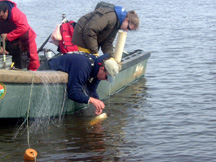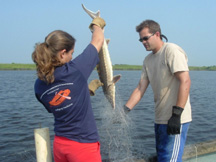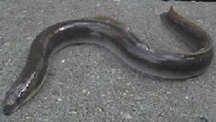Diadromous Fish Research

Photo by B.Post, SCDNR
Atlantic sturgeon, shortnose sturgeon, American shad, hickory shad, and American eels all once supported valuable fisheries in SC. Currently, though, shortnose sturgeon is listed as an Endangered Species, and similar listings have recently been proposed for Atlantic sturgeon and eels.

gill net.
Photo by A. Hazel, SCDNR
Our sturgeon research is generating valuable information on diet, which has been lacking in the South, and collecting samples for genetic comparison of fish from various rivers. In addition, we continue standardized sampling of both species in order to determine long-term abundance trends of young fish; ours is the only such sampling program in the South. Recent collections of baby fish of both species in the Edisto River confirms there was successful spawning this year.

Photo by B. Post, SCDNR
Shad research includes both fishery-dependant (getting data from recreational and commercial fishermen) and fishery-independant (standardized scientific collections) sampling. Using this approach we monitor abundance, determine age distribution, collect genetic samples, and collect information on how angling success may vary with water level and flow rate. Our results will be used in a 5-year stock assessment conducted by the Atlantic States Marine Fisheries Commission.

Research on the American eel consists of standardized sampling of elvers (baby eels) abundance. Eel sampling results from 2005 indicate that elvers were very abundant, even more so than in previous years.
